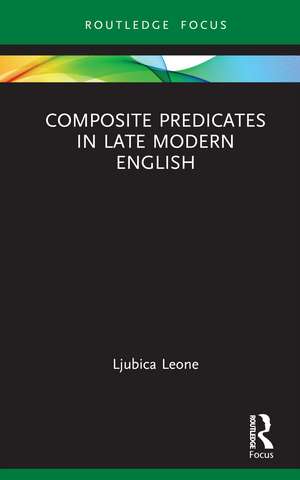Composite Predicates in Late Modern English: Routledge Focus on Linguistics
Autor Ljubica Leoneen Limba Engleză Hardback – 29 mai 2024
While previous scholarship on CPs exists from a synchronic perspective, this book is the first to focus exclusively on Late Modern English with a diachronic approach to CPs, understood as phraseological verbs consisting of a verb and a deverbal noun or this combination with a preposition, such as to ask a question or to take hold of. The volume builds on real-life spoken data encompassing the proceedings of the Old Bailey at the Central Criminal Court in London, which predate the invention of audio-recording technology. Leone explores syntactic and semantic changes and the role performed by phenomena associated with grammaticalization, lexicalization and idiomatization in this period from both quantitative and qualitative perspectives.
The book sheds light on ongoing processes of change in spoken data, enriching knowledge on language change in this period and offering directions for future research. This book will appeal to scholars in English historical linguistics, syntax and semantics, and language change.
Preț: 382.39 lei
Preț vechi: 415.64 lei
-8% Nou
Puncte Express: 574
Preț estimativ în valută:
73.19€ • 79.53$ • 61.52£
73.19€ • 79.53$ • 61.52£
Carte disponibilă
Livrare economică 31 martie-14 aprilie
Livrare express 14-20 martie pentru 26.52 lei
Preluare comenzi: 021 569.72.76
Specificații
ISBN-13: 9781032524887
ISBN-10: 103252488X
Pagini: 94
Ilustrații: 8
Dimensiuni: 138 x 216 x 12 mm
Greutate: 0.33 kg
Ediția:1
Editura: Taylor & Francis
Colecția Routledge
Seria Routledge Focus on Linguistics
Locul publicării:Oxford, United Kingdom
ISBN-10: 103252488X
Pagini: 94
Ilustrații: 8
Dimensiuni: 138 x 216 x 12 mm
Greutate: 0.33 kg
Ediția:1
Editura: Taylor & Francis
Colecția Routledge
Seria Routledge Focus on Linguistics
Locul publicării:Oxford, United Kingdom
Public țintă
PostgraduateCuprins
List of figures
List of tables
Acknowledgments
List of abbreviations and conventions
Chapter 1. Composite predicates in 1750–1850
1.1. Background
1.2. Linguistic overview of composite predicates
1.3. Previous studies and research aims
1.4. The corpus: the Late Modern English-Old Bailey Corpus
1.4.1. Corpus compilation: source data, sampling, text types
1.4.2. Corpus architecture and size
1.5. Method: selectional criteria, corpus-based techniques, and statistical tests
1.6. The structure of the book
Chapter 2. History
2.1. Old English and Middle English: the establishment of composite predicates
2.2. Early Modern English: the spread of composite predicates
2.3. Late Modern English: stability and change
2.4. Present Day English: current forms and uses
Chapter 3. Linguistic Features
3.1. Distribution of composite predicates
3.2. The base verbs
3.3. Phrasal profile and productivity of composite predicates
3.3.1. Phraseological variation across the years 1750–1850
3.3.2. The use of deverbal nouns with more than one verb
3.3.3. Productivity
Chapter 4. Composite Predicates Between Stability and Change
4.1. Stable composite predicates
4.2. Morpho-syntactic features of composite predicate
4.2.1. Syntactic patterns
4.2.2. Articles and determiners
4.2.3. Internal modification
4.2.4. The use of plural forms
4.2.5. Passivization
4.3. Semantic features
Chapter 5. Processes of change
5.1. Grammaticalization and lexicalization
5.2. Phraseological variation and layering between alternative prepositions
5.3. The coinage of new composite predicates
5.4. Semantic change
Chapter 6. Conclusion
Appendix: list of composite predicates
References
Index
List of tables
Acknowledgments
List of abbreviations and conventions
Chapter 1. Composite predicates in 1750–1850
1.1. Background
1.2. Linguistic overview of composite predicates
1.3. Previous studies and research aims
1.4. The corpus: the Late Modern English-Old Bailey Corpus
1.4.1. Corpus compilation: source data, sampling, text types
1.4.2. Corpus architecture and size
1.5. Method: selectional criteria, corpus-based techniques, and statistical tests
1.6. The structure of the book
Chapter 2. History
2.1. Old English and Middle English: the establishment of composite predicates
2.2. Early Modern English: the spread of composite predicates
2.3. Late Modern English: stability and change
2.4. Present Day English: current forms and uses
Chapter 3. Linguistic Features
3.1. Distribution of composite predicates
3.2. The base verbs
3.3. Phrasal profile and productivity of composite predicates
3.3.1. Phraseological variation across the years 1750–1850
3.3.2. The use of deverbal nouns with more than one verb
3.3.3. Productivity
Chapter 4. Composite Predicates Between Stability and Change
4.1. Stable composite predicates
4.2. Morpho-syntactic features of composite predicate
4.2.1. Syntactic patterns
4.2.2. Articles and determiners
4.2.3. Internal modification
4.2.4. The use of plural forms
4.2.5. Passivization
4.3. Semantic features
Chapter 5. Processes of change
5.1. Grammaticalization and lexicalization
5.2. Phraseological variation and layering between alternative prepositions
5.3. The coinage of new composite predicates
5.4. Semantic change
Chapter 6. Conclusion
Appendix: list of composite predicates
References
Index
Notă biografică
Ljubica Leone is currently a postdoctoral fellow at the University of Milan, Italy. She received her PhD in Literary and Linguistic Studies from the University of Salerno, Italy.
Descriere
This volume provides a concise overview of the diachronic development of composite predicates (CPs) in Late Modern English, offering clearer evidence of ongoing language change using data less readily available in other corpora.













